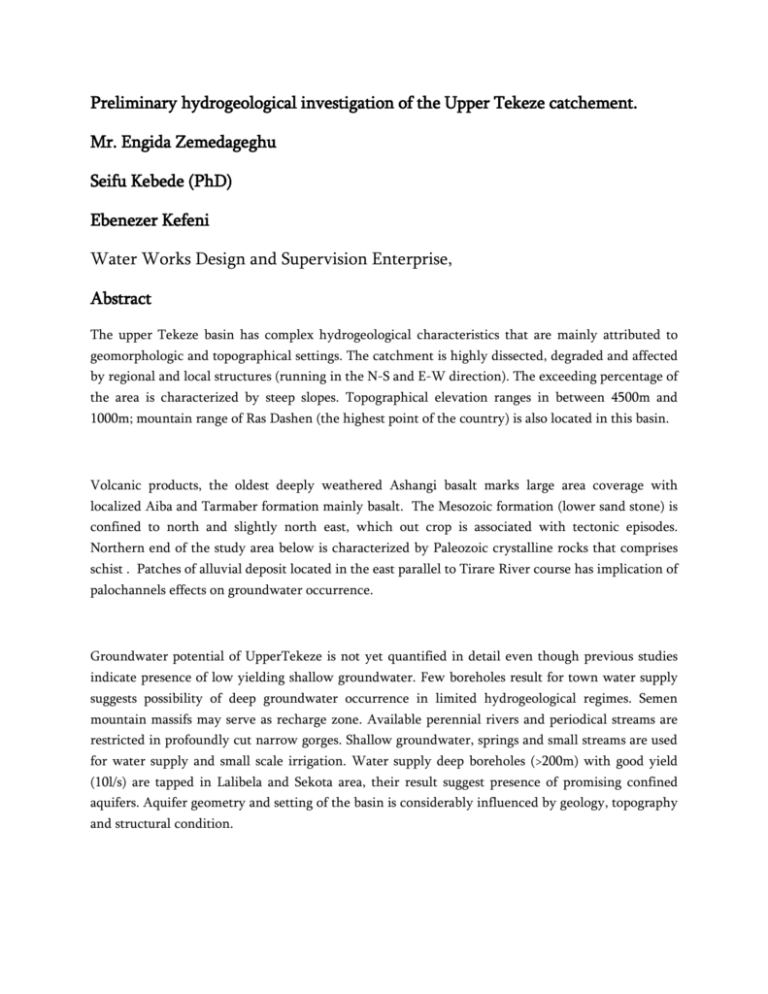Preliminary hydrogeological investigation of the Upper Tekeze
advertisement

Preliminary hydrogeological investigation of the Upper Tekeze catchement. Mr. Engida Zemedageghu Seifu Kebede (PhD) Ebenezer Kefeni Water Works Design and Supervision Enterprise, Abstract The upper Tekeze basin has complex hydrogeological characteristics that are mainly attributed to geomorphologic and topographical settings. The catchment is highly dissected, degraded and affected by regional and local structures (running in the N-S and E-W direction). The exceeding percentage of the area is characterized by steep slopes. Topographical elevation ranges in between 4500m and 1000m; mountain range of Ras Dashen (the highest point of the country) is also located in this basin. Volcanic products, the oldest deeply weathered Ashangi basalt marks large area coverage with localized Aiba and Tarmaber formation mainly basalt. The Mesozoic formation (lower sand stone) is confined to north and slightly north east, which out crop is associated with tectonic episodes. Northern end of the study area below is characterized by Paleozoic crystalline rocks that comprises schist . Patches of alluvial deposit located in the east parallel to Tirare River course has implication of palochannels effects on groundwater occurrence. Groundwater potential of UpperTekeze is not yet quantified in detail even though previous studies indicate presence of low yielding shallow groundwater. Few boreholes result for town water supply suggests possibility of deep groundwater occurrence in limited hydrogeological regimes. Semen mountain massifs may serve as recharge zone. Available perennial rivers and periodical streams are restricted in profoundly cut narrow gorges. Shallow groundwater, springs and small streams are used for water supply and small scale irrigation. Water supply deep boreholes (>200m) with good yield (10l/s) are tapped in Lalibela and Sekota area, their result suggest presence of promising confined aquifers. Aquifer geometry and setting of the basin is considerably influenced by geology, topography and structural condition. Field and Laboratory water quality analysis of Upper Tekeze basin demonstrates its suitability for both irrigation and water supply. Water samples collected from the highland are fresher than those obtained from the low lands. The maximum chemical concentration record is noted in water samples taken from the sedimentary formation in Sekota area. Due to ambient rock water interaction, solubility of the rock and residence time samples from the sedimentary formation tends to have higher TDS. Generally, the water is Ca-HCO3- type having 470µS/cm average electrical conductivity seldom showing considerable concentration of chloride and sulphate. Geological, Hydrogeological and Geophysical investigations were so far used to delinate potentially high groundwater potential zones. The zones are localized to the Belesa plain in the left bank of the Tekeze River, the Lalibela plain in the right bank and the Sekota area. Possibilities of using the groundwater for irrigation at large scale and house hold scales will be investigated under the project. The principal objective of this work is to map the groundwater resources and quantify the groundwater potential of the basin. Recharge, aquifer geometry, groundwater occurrence, water quality will be investigated. It is envisaged to produce hydro-geological map at scale of 1:250,000. Hydrogeological maps at scale of 1:50000 will be prepared for selected sites.











